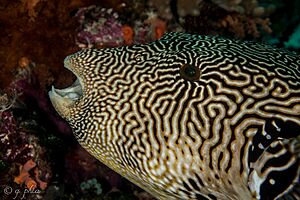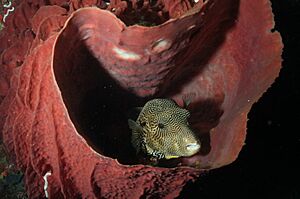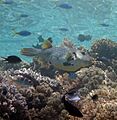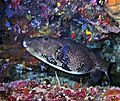Map puffer facts for kids
Quick facts for kids Map puffer |
|
|---|---|
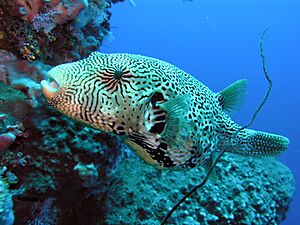 |
|
| Conservation status | |
| Scientific classification |
The map puffer (also called the map pufferfish or scribbled pufferfish) is a cool marine fish that lives near the bottom of the ocean. It belongs to the family called Tetraodontidae, which are known for their unique shapes. You can find map puffers in warm, tropical waters from the Indian Ocean all the way to the western Pacific Ocean.
This fish has a secret weapon: it contains a very strong and deadly chemical called tetrodotoxin. This chemical helps the map puffer stay safe from predators. Even though it's highly poisonous, you might sometimes see map puffers in aquariums or even in special food markets where they are prepared very carefully.
Contents
About the Map Puffer
The map puffer, known scientifically as Arothron mappa, is a medium-sized fish. It can grow up to about 65 centimeters (about 25 inches) long. Its body is shaped like an oval, a bit round but also stretched out. Instead of scales, most of the map puffer's body is covered with tiny, spiky bumps. These bumps are called dermal spines. The areas around its mouth, fins, and tail are smooth.
This fish doesn't have pelvic fins, and it also doesn't have a lateral line (which is a special sensory organ many fish have). Its dorsal fin and anal fin are small and are located near its tail. The map puffer has a short snout with two pairs of nostrils. Its mouth has four strong teeth that are joined together, forming a sharp beak. These teeth keep growing throughout the fish's life. To keep them from getting too long, the map puffer has to constantly chew on hard-shelled prey.
The map puffer's body is usually whitish with a thick pattern of black, brown, or greenish lines that look like a broken map. It also has a line that spreads out from its eye. Some map puffers might have dark or yellowish spots around their mouth, on their fins, or other parts of their body.
Where Map Puffers Live
You can find Arothron mappa in the warm, tropical and subtropical waters of the Indian Ocean and the western Pacific Ocean. Adult map puffers often live near deep drop-offs, clear lagoons, and sheltered reefs. They can be found from the water's surface down to about 30 meters (almost 100 feet) deep. Younger map puffers, called juveniles, prefer to live in seagrass beds.
What Map Puffers Eat
The map puffer eats different kinds of creatures that live on the ocean floor. Its diet includes benthic invertebrates (animals without backbones that live on the bottom), crustaceans like crabs and shrimp, sponges, and different types of algaes.
Map Puffer Behavior
This pufferfish is diurnal, which means it is active during the day. It also tends to be a loner, preferring to swim by itself rather than in groups.
Map Puffer Life Cycle and Reproduction
The map puffer has an interesting way of finding a mate and laying eggs. First, a male map puffer builds a large, flat circle on the ocean floor. He uses his fins to dig and stir up sand particles to create this special spot. Inside the circle, he digs geometric patterns of valleys and ridges, making a complex, maze-like design. This amazing sand structure is both a way to attract females and a safe place for eggs to be laid.
When a female map puffer comes near the nest, the male swims around and stirs the sand. This helps get the female's attention. If the female likes the male's display, she will enter the nest and release her eggs. The male then fertilizes these eggs. The fertilized eggs stay and develop inside the nest until they hatch into tiny larvae that float in the water.
How Map Puffers Defend Themselves
The map puffer is famous for having tetrodotoxin, an extremely powerful chemical. This toxin works by blocking nerve signals in predators, which helps protect the pufferfish. Interestingly, map puffers don't make this toxin themselves. Instead, tiny bacteria that live inside the pufferfish produce it. The pufferfish gets these bacteria, and the toxin, through its food chain.
Map Puffer as Food
Even though map puffers contain tetrodotoxin, some types of pufferfish are considered a special food in Japan. Studies have shown that the meat of the map puffer can be eaten safely by people. However, the skin, liver, reproductive organs, and intestines of the map puffer should never be eaten. These parts contain very high amounts of the dangerous tetrodotoxin.
Because of the danger, special training is needed to prepare pufferfish that contain tetrodotoxin. Chefs must be very careful not to let the toxin from the skin and organs touch the edible meat. However, some pufferfish raised on fish farms in Japan are fed a special diet. This diet makes them non-toxic, so even their liver can be eaten safely, like a delicacy called foie gras, without any harmful effects.
Images for kids



